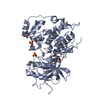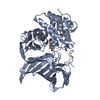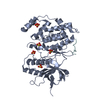[English] 日本語
 Yorodumi
Yorodumi- PDB-2h96: Discovery of Potent, Highly Selective, and Orally Bioavailable Py... -
+ Open data
Open data
- Basic information
Basic information
| Entry | Database: PDB / ID: 2h96 | ||||||
|---|---|---|---|---|---|---|---|
| Title | Discovery of Potent, Highly Selective, and Orally Bioavailable Pyridine Carboxamide C-jun NH2-terminal Kinase Inhibitors | ||||||
 Components Components |
| ||||||
 Keywords Keywords | TRANSCRIPTION / JNK1 / C-JUN N-TERMINAL KINASE / PROTEIN KINASE JNK1 INHIBITORS / PYRIDINE CARBOXAMIDE INHIBITORS | ||||||
| Function / homology |  Function and homology information Function and homology informationdentate gyrus mossy fiber / JUN phosphorylation / positive regulation of cell killing / regulation of CD8-positive, alpha-beta T cell proliferation / basal dendrite / Activation of BMF and translocation to mitochondria / Interleukin-38 signaling / negative regulation of JUN kinase activity / positive regulation of protein localization to mitochondrion / JUN kinase activity ...dentate gyrus mossy fiber / JUN phosphorylation / positive regulation of cell killing / regulation of CD8-positive, alpha-beta T cell proliferation / basal dendrite / Activation of BMF and translocation to mitochondria / Interleukin-38 signaling / negative regulation of JUN kinase activity / positive regulation of protein localization to mitochondrion / JUN kinase activity / Activation of BIM and translocation to mitochondria / WNT5:FZD7-mediated leishmania damping / MAP-kinase scaffold activity / JUN kinase binding / positive regulation of cyclase activity / mitogen-activated protein kinase kinase binding / mitogen-activated protein kinase kinase kinase binding / regulation of JNK cascade / histone deacetylase regulator activity / NRAGE signals death through JNK / Activation of the AP-1 family of transcription factors / positive regulation of NLRP3 inflammasome complex assembly / Fc-epsilon receptor signaling pathway / negative regulation of intrinsic apoptotic signaling pathway / dendritic growth cone / protein kinase inhibitor activity / positive regulation of protein metabolic process / peptidyl-threonine phosphorylation / mitogen-activated protein kinase / kinesin binding / regulation of macroautophagy / response to mechanical stimulus / axonal growth cone / stress-activated MAPK cascade / response to UV / energy homeostasis / negative regulation of protein binding / vesicle-mediated transport / JNK cascade / protein serine/threonine kinase binding / NRIF signals cell death from the nucleus / cellular response to amino acid starvation / JNK (c-Jun kinases) phosphorylation and activation mediated by activated human TAK1 / cellular response to reactive oxygen species / FCERI mediated MAPK activation / positive regulation of JNK cascade / cellular response to mechanical stimulus / regulation of circadian rhythm / peptidyl-serine phosphorylation / mitochondrial membrane / histone deacetylase binding / cellular senescence / Signaling by ALK fusions and activated point mutants / rhythmic process / MAPK cascade / regulation of protein localization / Recruitment and ATM-mediated phosphorylation of repair and signaling proteins at DNA double strand breaks / cellular response to lipopolysaccharide / response to oxidative stress / cellular response to oxidative stress / protein phosphatase binding / Oxidative Stress Induced Senescence / protein phosphorylation / positive regulation of apoptotic process / axon / protein serine kinase activity / neuronal cell body / protein serine/threonine kinase activity / synapse / positive regulation of gene expression / regulation of DNA-templated transcription / endoplasmic reticulum membrane / negative regulation of apoptotic process / perinuclear region of cytoplasm / enzyme binding / nucleoplasm / ATP binding / nucleus / plasma membrane / cytosol / cytoplasm Similarity search - Function | ||||||
| Biological species |  Homo sapiens (human) Homo sapiens (human) | ||||||
| Method |  X-RAY DIFFRACTION / X-RAY DIFFRACTION /  SYNCHROTRON / SYNCHROTRON /  MOLECULAR REPLACEMENT / Resolution: 3 Å MOLECULAR REPLACEMENT / Resolution: 3 Å | ||||||
 Authors Authors | Abad-Zapatero, C. | ||||||
 Citation Citation |  Journal: J.Med.Chem. / Year: 2006 Journal: J.Med.Chem. / Year: 2006Title: Discovery of potent, highly selective, and orally bioavailable pyridine carboxamide c-Jun NH2-terminal kinase inhibitors. Authors: Zhao, H. / Serby, M.D. / Xin, Z. / Szczepankiewicz, B.G. / Liu, M. / Kosogof, C. / Liu, B. / Nelson, L.T. / Johnson, E.F. / Wang, S. / Pederson, T. / Gum, R.J. / Clampit, J.E. / Haasch, D.L. ...Authors: Zhao, H. / Serby, M.D. / Xin, Z. / Szczepankiewicz, B.G. / Liu, M. / Kosogof, C. / Liu, B. / Nelson, L.T. / Johnson, E.F. / Wang, S. / Pederson, T. / Gum, R.J. / Clampit, J.E. / Haasch, D.L. / Abad-Zapatero, C. / Fry, E.H. / Rondinone, C. / Trevillyan, J.M. / Sham, H.L. / Liu, G. #1:  Journal: J.Med.Chem. / Year: 2006 Journal: J.Med.Chem. / Year: 2006Title: Aminopyridine-Based c-Jun N-Terminal Kinase Inhibitors with Cellular Activity and Minimal Cross-Kinase Activity. Authors: Szczepankiewicz, B.G. / Kosogof, C. / Nelson, L.T. / Liu, G. / Liu, B. / Zhao, H. / Serby, M.D. / Xin, Z. / Liu, M. / Gum, R.J. / Haasch, D.L. / Wang, S. / Clampit, J.E. / Johnson, E.F. / ...Authors: Szczepankiewicz, B.G. / Kosogof, C. / Nelson, L.T. / Liu, G. / Liu, B. / Zhao, H. / Serby, M.D. / Xin, Z. / Liu, M. / Gum, R.J. / Haasch, D.L. / Wang, S. / Clampit, J.E. / Johnson, E.F. / Lubben, T.H. / Stashko, M.A. / Olejniczak, E.T. / Sun, C. / Dorwin, S.A. / Haskins, K. / Abad-Zapatero, C. / Fry, E.H. / Hutchins, C.W. / Sham, H.L. / Rondinone, C.M. / Trevillyan, J.M. #2:  Journal: Bioorg.Med.Chem.Lett. / Year: 2006 Journal: Bioorg.Med.Chem.Lett. / Year: 2006Title: Synthesis and SAR of 1,9-dihydro-9-hydroxypyrazolo[3,4-b]quinolin-4-ones as novel, selective c-Jun N-terminal kinase inhibitors. Authors: Liu, M. / Xin, Z. / Clampit, J.E. / Wang, S. / Gum, R.J. / Haasch, D.L. / Trevillyan, J.M. / Abad-Zapatero, C. / Fry, E.H. / Sham, H.L. / Liu, G. | ||||||
| History |
| ||||||
| Remark 999 | SEQUENCE THE NATIVE, UNMUTATED SEQUENCE IS THE SAME AS THE P45983-2 ISOFORM. THE INTRODUCED ...SEQUENCE THE NATIVE, UNMUTATED SEQUENCE IS THE SAME AS THE P45983-2 ISOFORM. THE INTRODUCED MUTATIONS (THR183>GLU, TYR185>GLU) ARE INTENDED TO MIMIC THE ACTIVATED FORM OF THE KINASE UPON PHOSPHORYLATION OF THOSE TWO RESIDUES. |
- Structure visualization
Structure visualization
| Structure viewer | Molecule:  Molmil Molmil Jmol/JSmol Jmol/JSmol |
|---|
- Downloads & links
Downloads & links
- Download
Download
| PDBx/mmCIF format |  2h96.cif.gz 2h96.cif.gz | 162.6 KB | Display |  PDBx/mmCIF format PDBx/mmCIF format |
|---|---|---|---|---|
| PDB format |  pdb2h96.ent.gz pdb2h96.ent.gz | 129.6 KB | Display |  PDB format PDB format |
| PDBx/mmJSON format |  2h96.json.gz 2h96.json.gz | Tree view |  PDBx/mmJSON format PDBx/mmJSON format | |
| Others |  Other downloads Other downloads |
-Validation report
| Summary document |  2h96_validation.pdf.gz 2h96_validation.pdf.gz | 546.7 KB | Display |  wwPDB validaton report wwPDB validaton report |
|---|---|---|---|---|
| Full document |  2h96_full_validation.pdf.gz 2h96_full_validation.pdf.gz | 595.1 KB | Display | |
| Data in XML |  2h96_validation.xml.gz 2h96_validation.xml.gz | 23 KB | Display | |
| Data in CIF |  2h96_validation.cif.gz 2h96_validation.cif.gz | 32.8 KB | Display | |
| Arichive directory |  https://data.pdbj.org/pub/pdb/validation_reports/h9/2h96 https://data.pdbj.org/pub/pdb/validation_reports/h9/2h96 ftp://data.pdbj.org/pub/pdb/validation_reports/h9/2h96 ftp://data.pdbj.org/pub/pdb/validation_reports/h9/2h96 | HTTPS FTP |
-Related structure data
| Related structure data |  2g01S S: Starting model for refinement |
|---|---|
| Similar structure data |
- Links
Links
- Assembly
Assembly
| Deposited unit | 
| ||||||||
|---|---|---|---|---|---|---|---|---|---|
| 1 | 
| ||||||||
| 2 | 
| ||||||||
| 3 |
| ||||||||
| Unit cell |
|
- Components
Components
| #1: Protein | Mass: 42919.559 Da / Num. of mol.: 2 / Fragment: JNK1-(1-364)-6His / Mutation: T183E,Y183E Source method: isolated from a genetically manipulated source Source: (gene. exp.)  Homo sapiens (human) / Gene: MAPK8, JNK1, PRKM8 / Production host: Homo sapiens (human) / Gene: MAPK8, JNK1, PRKM8 / Production host:  References: UniProt: P45983, mitogen-activated protein kinase #2: Protein/peptide | Mass: 1345.612 Da / Num. of mol.: 2 / Fragment: PEPJIP1 PEPTIDE / Source method: obtained synthetically Details: THE SEQUENCE IS FOUND NATURALLY IN HOMO SAPIENS (HUMAN). References: UniProt: Q9UQF2 #3: Chemical | ChemComp-SO4 / #4: Chemical | #5: Chemical | |
|---|
-Experimental details
-Experiment
| Experiment | Method:  X-RAY DIFFRACTION / Number of used crystals: 1 X-RAY DIFFRACTION / Number of used crystals: 1 |
|---|
- Sample preparation
Sample preparation
| Crystal | Density Matthews: 4.94 Å3/Da / Density % sol: 75.11 % |
|---|---|
| Crystal grow | pH: 6.2 Details: PROTEIN WAS PREINCUBATED WITH THE JIP1 PEPTIDE AT A 5X MOLAR EXCESS. PROTEIN CONCENTRATION 9- 12.6 MG/ML. HANGING DROPS CONSISTED OF 2UL PROTEIN PLUS 2 UL WELL SOLUTION. WELL SOLUTION:2.8-3. ...Details: PROTEIN WAS PREINCUBATED WITH THE JIP1 PEPTIDE AT A 5X MOLAR EXCESS. PROTEIN CONCENTRATION 9- 12.6 MG/ML. HANGING DROPS CONSISTED OF 2UL PROTEIN PLUS 2 UL WELL SOLUTION. WELL SOLUTION:2.8-3.1 M AMMONIUM SULFATE, 10- 14% GLYCEROL. FOR CO-CRYSTALLIZATION EXPERIMENT WITH THE COMPOUND, THE COMPOUND WAS DISSOLVED IN DMSO AT 100 MM CONCENTRATION. ALLOW TO INCUBATE FOR AT LEAST AN HOUR ON ICE. SOLUTION WAS SPUN FOR 5 MINUTES AT 2000G PRIOR TO SETTING UP FOR CRYSTALLIZATION, PH 6.2, VAPOR DIFFUSION, HANGING DROP, TEMPERATURE 277.0K, pH 6.20 |
-Data collection
| Diffraction | Mean temperature: 110 K |
|---|---|
| Diffraction source | Source:  SYNCHROTRON / Site: SYNCHROTRON / Site:  APS APS  / Beamline: 17-ID / Wavelength: 1 / Beamline: 17-ID / Wavelength: 1 |
| Detector | Type: ADSC QUANTUM 210 / Detector: CCD / Date: Oct 18, 2004 |
| Radiation | Protocol: SINGLE WAVELENGTH / Monochromatic (M) / Laue (L): M / Scattering type: x-ray |
| Radiation wavelength | Wavelength: 1 Å / Relative weight: 1 |
| Reflection | Resolution: 3→20 Å / Num. all: 34786 / Num. obs: 31447 / % possible obs: 89.1 % / Observed criterion σ(I): 1 / Redundancy: 7.2 % / Biso Wilson estimate: 54.6 Å2 / Rmerge(I) obs: 0.094 / Rsym value: 0.094 / Net I/σ(I): 22.5 |
| Reflection shell | Resolution: 3→3.11 Å / Redundancy: 6.8 % / Rmerge(I) obs: 0.754 / Mean I/σ(I) obs: 2.2 / Num. unique all: 3461 / Rsym value: 0.754 / % possible all: 99.5 |
- Processing
Processing
| Software |
| |||||||||||||||||||||||||
|---|---|---|---|---|---|---|---|---|---|---|---|---|---|---|---|---|---|---|---|---|---|---|---|---|---|---|
| Refinement | Method to determine structure:  MOLECULAR REPLACEMENT MOLECULAR REPLACEMENTStarting model: 2G01 Resolution: 3→19.97 Å / Rfactor Rfree error: 0.005 / Data cutoff high absF: 419658.34 / Data cutoff low absF: 0 / Isotropic thermal model: RESTRAINED / Cross valid method: THROUGHOUT / σ(F): 2 Details: Due to a feature in the refinement program, the structure was refined with OXT on one or more residues that is not the terminal residue of the sequence. In all these instances the OXT was ...Details: Due to a feature in the refinement program, the structure was refined with OXT on one or more residues that is not the terminal residue of the sequence. In all these instances the OXT was changed to N of the next residue. THE AUTHOR STATES: ALTHOUGH THE DATA IN THE HIGHEST RESOLUTION SHELL HAD POOR AGREEMENT FACTOR, IT WAS DECIDED TO INCLUDE THEM IN THE REFINEMENT BECAUSE THEY WERE RELATIVELY STRONG FOR THESE WEAK-DIFFRACTING CRYSTALS AND TO ADD MORE DATA GIVEN THE LARGE NUMBER OF ATOMS IN THE ASYMMETRIC UNIT. THE REFINEMENT OF INDIVIDUAL, RESTRAINT, B-FACTORS DROPPED BOTH THE R- AND THE R-FREE AND SO IT WAS CONSIDERED TO BE REASONABLE. HOWEVER, THE INDIVIDUAL VALUES REFLECT MORE TRENDS THAN INDIVIDUAL DIFFERENCES. THEY HAVE BEEN RETAINED IN THE ENTRY SPECIALLY TO SHOW DIFFERENCES BETWEEN THE SO4 IONS AND LIGANDS, AND AMONG DIFFERENT AMINO ACIDS IN THE CHAIN. THE DIFFERENCES AMONG INDIVDUAL ATOMS/GROUPS WITHIN EACH RESIDUE SHOULD BE CONSIDERED ONLY AS A TREND.
| |||||||||||||||||||||||||
| Solvent computation | Solvent model: FLAT MODEL / Bsol: 25.0512 Å2 / ksol: 0.29954 e/Å3 | |||||||||||||||||||||||||
| Displacement parameters | Biso mean: 59.4 Å2
| |||||||||||||||||||||||||
| Refine analyze |
| |||||||||||||||||||||||||
| Refinement step | Cycle: LAST / Resolution: 3→19.97 Å
| |||||||||||||||||||||||||
| Refine LS restraints |
| |||||||||||||||||||||||||
| LS refinement shell | Resolution: 3→3.11 Å / Rfactor Rfree error: 0.027 / Total num. of bins used: 10
| |||||||||||||||||||||||||
| Xplor file |
|
 Movie
Movie Controller
Controller













 PDBj
PDBj












